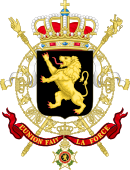From Wikipedia, the free encyclopedia
1946 Belgian general election
First party
Second party
Third party
Leader
Hubert Pierlot
Paul-Henri Spaak
Julien Lahaut
Party
Christian Social
Socialist
PVDA-PTB
Leader since
Candidate for PM?
Candidate for PM
1945
Last election
73 seats, 33.58%
64 seats, 29.44%
9 seats, 4.65%
Seats won
92
69
23
Seat change
Popular vote
1,006,293
746,738
300,099
Percentage
42.54%
31.57%
12.69%
Swing
Fourth party
Fifth party
Leader
Roger Motz
Pierre Clerdent Antoine Delfosse
Party
Liberal
Democratic Union
Leader since
1945
1945
Last election
33 seats, 17.18%
New party
Seats won
17
1
Seat change
Popular vote
211,143
51,095
Percentage
8.93%
2.16%
Swing
General elections were held in Belgium on 17 February 1946.[ 1] Christian Social Party , which won 92 of the 202 seats in the Chamber of Representatives and 51 of the 101 seats in the Senate .[ 2] [ 3]
They were the first elections after the Second World War and saw fundamental changes among the political parties. The Flemish National Union , which held 17 seats prior to the war and collaborated with Nazi Germany during the war, was outlawed. The Catholic Party changed into the Christian Social Party while the Belgian Labour Party changed into the Belgian Socialist Party . The Liberal Party suffered major losses, while the Christian Social Party and the Communist Party made major gains. Despite this, the Socialist Party led by Paul-Henri Spaak formed a minority government, which fell shortly after.
Results
Chamber of Deputies
Party
Votes
%
Seats
Christian Social Party 1,006,293
42.54
92
Belgian Socialist Party 746,738
31.57
69
Communist Party of Belgium 300,099
12.69
23
Liberal Party 211,143
8.93
17
Belgian Democratic Union 51,095
2.16
1
Liberal-Socialist Kartels
37,844
1.60
0
Union des métiers
3,360
0.14
0
FRENSSEN
2,480
0.10
0
Independents
2,785
0.12
0
Walloon Unity Party
1,774
0.07
0
Belgian People's Movement
865
0.04
0
Resistant
676
0.03
0
Middle Classes
274
0.01
0
Belgian Free Independents
212
0.01
0
Invalid/blank votes
94,971
–
–
Total 2,460,609 100 202
Registered voters/turnout
2,724,796
90.30
–
Source: Belgian Elections
Senate
Party
Votes
%
Seats
Christian Social Party 999,264
42.74
51
Belgian Socialist Party 729,943
31.22
34
Communist Party of Belgium 300,655
12.86
11
Liberal Party 214,837
9.19
4
Belgian Democratic Union 48,441
2.07
0
Liberal-Socialist Kartels
33,732
1.44
1
Union des métiers
3,764
0.16
0
Demarrez
3,753
0.16
0
Independents
3,866
0.17
0
Invalid/blank votes
106,767
–
–
Total 2,445,022 100 101
Source: Belgian Elections
References





